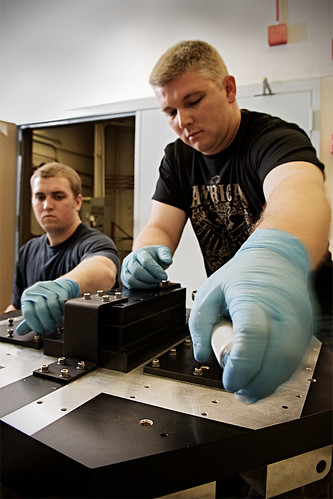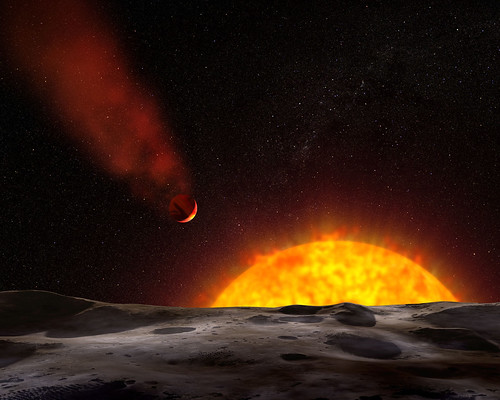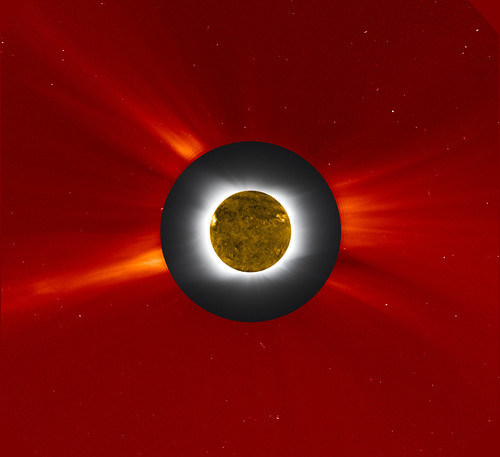Awesomeness Round-up – 7/19/10
- By Maggie Masetti
- July 19, 2010
- 3 Comments
Want a real behind-the-scenes look at the James Webb Space Telescope’s mirror segments being prepared for cryo testing?
We’ve mentioned that the box that will contain Webb’s instruments (called the ISIM) is here at Goddard being tested. Well, how do you test its strength? One way is by putting dummy weights in it that are the same mass and shape as the real instruments! Just one of the little things that you don’t often hear about!
Credit:NASA/Chris Gunn
There’s no planet like home… how’d you like to live here? This planet (discovered using Hubble) is so heated from being close to its star, that its atmosphere is escaping. The gas giant (HD 209458b) actually looks like a comet, due to stellar winds sweeping its cast-off atmosphere behind it, like a tail! Here’s an artist impression:
Illustration Credit: NASA, ESA, and G. Bacon (STScI)
In case you weren’t able to make it to Easter Island to see the recent solar eclipse, here’s a photo from the Williams College Expedition. I know I’d love to see Easter Island, but seeing a solar eclipse there would be even more amazing! The Williams image is the gray and white – it’s embedded with an image of the Sun’s outer corona from the LASCO instrument on SOHO (red false color). The dark silhouette of the moon is covered by an extreme UV image of the Sun taken at about the same time by SDO. Find out more about this unusual composite image.
Credits: Williams College Eclipse Expedition — Jay M. Pasachoff, Muzhou Lu, and Craig Malamut; SOHO’s LASCO image courtesy of NASA/ESA; solar disk image from NASA’s SDO; compositing by Steele Hill, NASA Goddard Space Flight Center.
This video stars a zoom from the southern sky then closing in on the stellar nursery NGC 2467. Wonderful imagery from Hubble!
The Geeked on Goddard blog has an interesting post on a gamma-ray burst (GRB) detected by the Swift satellite on June 21st, that also let out a burst of X-rays that was so record-breakingly bright that scientist Phil Evans’ software thought the value was an error! How record-breaking was it? To quote Geeked on Goddard, “The next brightest such object in X-rays was 2008’s naked-eye GRB 080319B. This GRB was seven times fainter but twice as far away as the June 21 event. But move the new record holder to the same distance, and it would still be 1.5 times as bright as GRB 080319B.” Wow!
Here’s another record breaker – astronomers using data from ESO’s Very Large Telescope and NASA’s Chandra X-ray telescope have found “the most powerful pair of jets ever seen from a stellar black hole.” The discovery was recently reported in Nature. The jets from this black hole are actually forming a bubble of hot gas 1000 light years across. The energetic jets of fast-moving particles are slamming into the surrounding interstellar gas – this heats it and triggers it to expand, inflating a bubble containing a mix of hot gas and particles. Astronomers can actually observe the spots where the jets are smashing into the gas around the black hole and have calculated that the bubble of gas is inflating at almost 1 million kilometers per hour!
“The length of the jets …is amazing, compared to the size of the black hole from which they are launched,” said co-author Robert Soria in an article on ESO.org. “If the black hole were shrunk to the size of a soccer ball, each jet would extend from the Earth to beyond the orbit of Pluto.” Astronomers believe that the jet activity has been occurring for at least 200,000 years!
This may have nothing to do with astronomy, but it is something that directly affected many of us who work at Goddard Space Flight Center, which is located in Maryland. At 5am on the morning of July 16, many of us were awakened by something which could have been a truck or an airplane rumbling by, but was actually an earthquake! I, sadly, slept through it. :-( However, many of us actually felt it – in fact, Sara blogged about it. Earthquakes are always a good time to do citizen science – if you felt it, you can report it to the USGS and they can use that data to map the quake. See Sara’s blog for more information and links!
Ok, we know to you folks in California and other, more earthquake-prone regions, that a 3.6 isn’t a big deal – but this was the first quake in our region to register above a 3 on the Richter scale since 1974!







[…] 19/07/2010 · Leave a Comment NASA’s Blueshift Blog has published its weekly news roundup. See it here. […]
I love learning about behind-the-scenes stuff. Thank you for the video.
Glad you enjoyed it, Julie! Thanks for the comment!